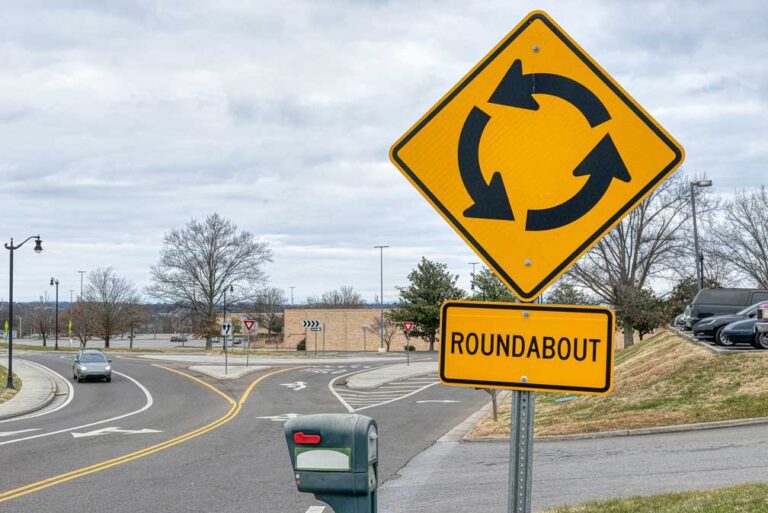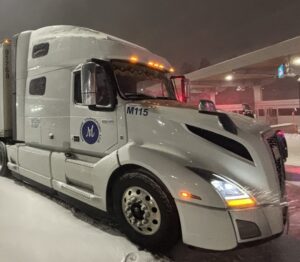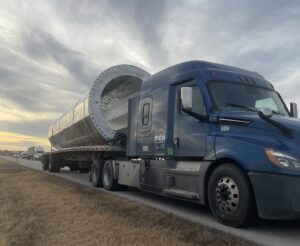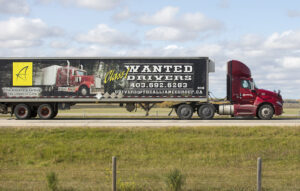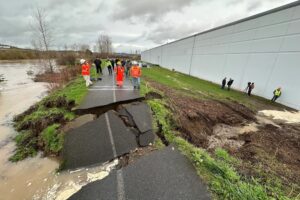CEDAR RAPIDS, Iowa — As roundabouts have become more mainstream in American city planning and road design, Cedar Rapids is planning to almost double their number in the city by the end of 2024.
Currently, Iowa’s second-largest city has 12 roundabouts. The city began its roundabout journey in 2017 when it constructed its first at Kirkwood Boulevard SW at Prairie Point Middle School.
The Gazette reports that roundabout, like in many communities around the country, has at times been a controversial topic in Eastern Iowa. Cedar Rapids’ neighbor to the northeast, Marion, has nine roundabouts of its own and has been the subject of jokes over the years, which were embraced through a Raygun shirt with the slogan: “Marion: Progressive in a Roundabout Way.”
In 2020, neighbors banded together to prevent the construction of a roundabout near Washington High School in Cedar Rapids.
And go online and visit any local neighborhood-run Facebook page and you’ll find a posts of someone complaining about other drivers not knowing how to properly use a roundabout.
Even with communication in the form of instructional videos and billboards from local governments, some residents feel they know how to use them — but that their fellow drivers do not.
“I lived in Cedar Falls when they completely reconstructed University Avenue to include several roundabouts and the construction process itself was atrocious,” Cedar Rapids resident Whitney Broghammer, 27, said. “When it was finally said and done, I didn’t find it any more beneficial than the stop lights that were there previously.”
“I’m all for the roundabouts,” said Cedar Rapids resident Skylar Becker, 26, who works near Ellis Boulevard where roundabouts were recently built. “People just got to get used to them. I’m comfortable with them.”
“I feel like a lot of people don’t know how to properly use them,” said Colleen McFarlane, 24, of Cedar Rapids. “Too many people stop rather than yield and in turn, that disrupts the flow of traffic, which takes away from the purpose of a roundabout.”
“I know how they’re supposed to be used, but I don’t think other drivers do. It’s like a guessing game if they are going to yield at all or if we are all going to collectively yield and not know who has the right of way,” said Mackenzie Kruzich, 28, of Iowa City. “At that point, a stop sign would be safer and probably just as, if not more, efficient timewise.”
Marion built its first roundabouts in the early 2010s: one, on Seventh Avenue and Seventh Street, beginning the transformation of Uptown Marion and the Sixth Avenue central corridor; and one on 35th Street and Alburnett Road on the north side of the city, laying some of the groundwork for the yet-to-be-completed and metro-spanning Tower Terrace Road. It is also the site of the commonly-named ‘Cornhenge’ art piece.
Iowa currently has about 60 roundabouts, according to the Iowa Department of Transportation.
But why do we have them? National and local traffic experts say the roundabouts are doing what they’re supposed to: prevent major crashes, bring down idling emissions and make traffic more efficient at problem intersections.
“Before the first one opened here in 2017, we would have a police officer help traffic around Prairie Point Middle School,” Cedar Rapids Traffic Engineer John Witt said. “He was super cool and would dress up for Halloween and stuff, but that model of traffic control isn’t sustainable. I went out there on the first day of having the roundabout and it instantly operated better than anyone could ever imagine.”
Daubs said that when compared to the traditional four-way intersection, local roundabouts have proved safer.
“At a normal four-way, if someone doesn’t yield, you’re looking at a T-Bone crash right in the middle of the door, which is the second-most deadly crash,” Daubs said. “With roundabouts, you’re angling. If there’s contact or a collision, it’s usually not detrimental. It’s usually more of an angled, glancing blow.”
Nationally, roundabouts have provided a 90 percent reduction in fatal crashes, a 76 percent reduction in injury crashes and a 40 percent reduction to pedestrian crashes, according to a study by the Insurance Institute for Highway Safety.
“Roundabouts benefit from good geometry, exhibiting only a fraction of the troublesome crash patterns typical of right-angle intersections,” the study said. “A typical four-legged intersection has 32 vehicle-to-vehicle conflict points and 24 vehicle-to-pedestrian conflict points. By comparison, a four-legged roundabout has only eight vehicle-to-vehicle conflict points and eight vehicle-to-pedestrian conflict points.”
Cedar Rapids’ Witt and Marion City Engineer Mike Barkalow both said that the cities do a lot of analysis before deciding where a roundabout should go, which includes modeling software.
“We do a comprehensive analysis whenever we’re looking at changing traffic control,” Witt said. “Safety is the No. 1 priority so if we have an intersection with more T-Bone crashes from running stop signs or red lights, those are typically a great location for a roundabout. … With the modeling software, roundabouts outperform other intersections in most cases.”
“We do traffic studies and obviously not every intersection is going to be roundabouts. We don’t just blindly put them in,” Barkalow said. “Each intersection gets evaluated to determine the best option, whether it is a four-way stop, two-way stop, signal, roundabout. We have the list and you look at each one and look at traffic counts, accidents, turning movements, a ton of factors go into it.”
The vast majority of roundabouts in Eastern Iowa are single-lane roundabouts. Witt said that will continue to be the norm.
“We’re not ready for a triple-lane roundabout in Cedar Rapids,” Witt said.
Daubs said it’s been a while since he’s heard any Marion roundabout jokes and hopes that means that residents are getting used to them.
“I think the jokes are dying out now. I think people are getting used to it. The younger generation is getting used to it,” said Daubs, who is also the school-resource officer for Linn-Mar. “I’m around high school students, I have yet to hear anything about roundabouts from students. It can be alarming for older folks because they’re newer, but I think everyone has pretty much come to the realization that roundabouts are here to stay.”The first modern U.S. roundabouts were built in the 1990s in Summerlin, Nevada. Before that, they have been used in Europe throughout the 20th century, becoming more popular in the 1960s. The first modern one was built in 1899 in Gorlitz, Germany.
But after decades of use with an estimated 9,000 roundabouts across the country, some drivers still struggle with yielding to the left. City websites as well as the Iowa Department of Transportation website all have instructional videos and articles about how to navigate the intersections.
At the time of construction, the city of Marion even had billboards with instructions on how to use the new roundabouts.
“It really is just look left and drive right,” Marion police public information officer Tom Daubs said. “People get upset when people treat it as a four-way stop. It’s not. You just slow down and get in. That’s the key. If someone is coming and you can’t get in, then you wait. But you got to get in.”
The Associated Press is an independent global news organization dedicated to factual reporting. Founded in 1846, AP today remains the most trusted source of fast, accurate, unbiased news in all formats and the essential provider of the technology and services vital to the news business. The Trucker Media Group is subscriber of The Associated Press has been granted the license to use this content on TheTrucker.com and The Trucker newspaper in accordance with its Content License Agreement with The Associated Press.








